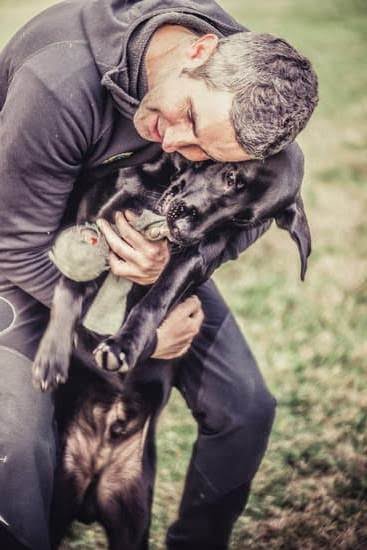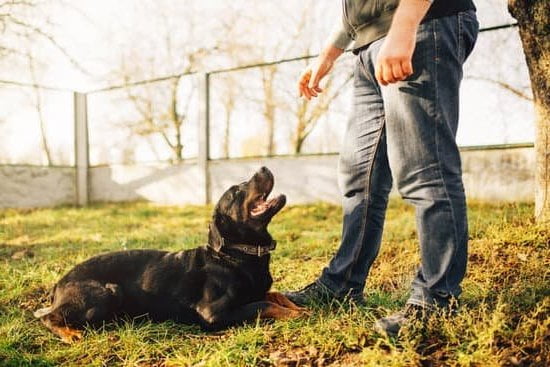Introduction
Dog training is the practice of teaching an animal behaviors and responses to command cues. It is important to train dogs for a variety of reasons; it can help them become better socialized, improve their physical health and mental stimulation, and make sure they learn basic manners. Training can also be used to teach a dog useful skills such as obedience and tricks.
Different kinds of dog training are available, tailored to the specific needs of each animal or owner. Obedience training focuses on teaching dogs commands like “sit” and “stay” so they understand what’s expected of them in certain situations. Socialization classes will help pets learn to interact appropriately with other animals and humans in various environments such as parks or homes. Agility classes make use of obstacle courses to teach dogs how to complete tricks safely and efficiently, while puppy classes focus on basic obedience for new owners who need to start from scratch in terms of behavioral instruction. Therapy pet programs enable owners the opportunity for their pet to be able to work one-on-one with individuals practicing therapeutic exercises designed by professional trainers. Dog owners may even find services geared specifically toward helping their pet overcome aggression or anxiety issues related to specific people, animals, or places. Ultimately, choosing the best dog training school should be based on factors such as location, cost, professionalism, credentials of staff members, types of services offered that best meet your individual needs; so take your time researching different schools before deciding which one fits best with your lifestyle.
Different Types of Dog Training Schools and Their Advantages
There are a variety of different types of dog training schools available. Some specialize in puppy training, while others offer classes for older and working dogs. Each type of school has its own advantages and disadvantages, so it’s important to consider your specific needs when deciding which one is the best for your pup.
Puppy Training Schools: Puppy training schools are specialized in teaching young pups basic commands, housebreaking skills, and how to interact with people and other animals in a safe environment. They also teach you how to train these skills incrementally over time to help ensure your pup remains well-behaved even once they are fully mature. The advantage of puppy training schools is that the instructors can tailor the instructions for each individual pup, because every pup will learn differently.
Obedience Training Schools: Obedience training schools focus on teaching your dog more advanced commands than basic obedience commands such as sit or stay. They also typically use more advanced methods such as clicker or marker training that involve using sounds or marking behavior immediately after your pup does something correctly. The advantage of this type of school is that you will have intensive one-on-one instruction from a trainer who knows how to influence your pup’s behavior in a positive way without resorting to punishment or negative reinforcement.
Agility Courses: Agility courses are designed specifically for dogs who excel at physical activities like jumping hurdles, running through tunnels, and negotiating obstacles. These types of classes will use positive reinforcement techniques like rewards and treats to encourage correct performance, while also making sure your pup stays physically fit by providing plenty of exercise opportunities throughout the course. Additionally, agility courses can be great fun for both owner and pet!
Tracking School: Tracking schools specialize in teaching dogs valuable skills like how to identify particular scents and follow trails reliably by smell alone (scent tracking). While scent tracking may not be useful for all owners or household pets, this type of tracking can be useful for those who need a reliable search and rescue partner or hunting companion. The great thing about attending tracking schools is that you don’t always need to spend months teaching these intricate behaviors yourself; some instructors will be able to showcase these behaviors within just a few weeks!
Evaluating Dog Training Schools
The best dog training schools will offer a variety of training programs and services to fit the needs of any pup, from puppy to adult. Here are some pros and cons of various training school options:
One-on-one Training: This is typically more expensive than group classes but allows for personalized attention where the trainer can use positive reinforcement techniques to target specific issues. Pros include better behavior results over shorter periods of time and possible focus on a wider range of behaviors or skills. Cons include increased cost, limited availability including scheduling issues if the trainer has a wait list, and distractions related to home visits.
Group Classes: Group classes are usually offered by municipalities or private trainers at local pet stores, veterinary clinics, etc. They tend to cost less than one-on-one sessions but require more patience as outcomes may not be seen right away. Pros include lower cost than individual lessons, socializing opportunities with other pets in the class, potential development of obedience commands in public settings (if held outdoors). Cons include more limited focus on particular issues compared to one-on-one sessions, lack of personalized instruction for each attendee depending on size and type of class, and lack of reward based methods—which have been thoroughly researched and proven effective—for some behavioral problems such as aggression or anxiety.
Boarding Programs: For those who need longer term solutions due to travel or rural living situations or who need their pets’ behavior corrected without having to worry about daily instruction at home, boarding program may be an option. Pros include long term lifestyle improvement for the pet if done properly with experienced instructors who can work one-on-one during preferred times when your pet cannot go home for extended periods of time (e.g., vacations), clearer communication between staff members who are always present versus family members who may change day things seem forgotten from hour to hour with animals at home; overall consistency/structure that can help solidify positive habits whereas changes in routine confuse certain dogs that do better following regular patterns especially in terms of settling after overstimulation from enrichment activities whilst other dogs thrive off rotation – both mental and physical stimulus; strict protocols which keep your pet safe so you don’t have to worry about them taking risks without you supervising; increase confidence dealing with novel experiences & ensure range/variety develop competency across wide range real life skills rather than just being able get along well only amongst family members in familiar surroundings (others as neighbours come & go) thanks head starts given via specialised materials etc.; additional opportunities making new friends/bonding with peers instead being isolated + stressed whilst you not around develop curiosity potentially independence however still enjoying security blanket companionship f he craves versus feeling alone & vulnerable side effects unlike if were left by themselves; Cons include additional expense extended duration e.g., weeks rather days or hours since this form instruction become permanent part lifestyle suggesting gradually culminating positive tips stayed behind times either upon takeoff modified homecoming depending extent guidance dedicated team have achieved
What to Look for When Interviewing Potential Dog Training Schools
When looking for the best dog training school, it is important to research each of the schools to determine which one is best suited for your needs. When interviewing potential schools, be sure to ask a variety of questions that address their methods, pricing, credentials and experience levels. Ask about their philosophy for dog training, what methods they use to encourage positive behaviors and how often you should expect training sessions. Additionally, inquire about their prices and any certificates or certifications necessary for staff at their facility. Make sure that the school follows safe, humane techniques that don’t utilize techniques like choking or striking because those can do more long-term harm than good. Finally, ask if the school offers different classes depending on the breed or age of your pet. By asking these questions before enrolling in any dog training program, you can ensure that you will find the right fit for you and your pup.
The Best Dog Training School
When it comes to choosing a dog training school, the best one for you depends on your particular needs. It is important to research different schools and find the one that will provide your beloved pet with the most effective and proven methods of training as well as a comfortable learning environment. Here are some benefits to look for when selecting the best dog training school:
• Experienced Instructors: You want to select a school staffed with experienced trainers who are well-versed in both traditional and innovative techniques. Training should be implemented safely, without compromising your dog’s mental or physical health. Look for certification from recognized organizations such as the Association of Professional Dog Trainers (APNDT).
• Quality Learning Materials: A good dog training school should provide quality learning materials including videos, books, pamphlets, and more. These resources should help owners understand their pet’s behavior better while equipping them with easy-to-follow instructions on how to train their dogs effectively.
• Open Class Structure: The classes should be open where owners can visit at any time to observe their dogs being trained. This will give them an opportunity to understand their pet’s progress and adjust their own training techniques accordingly.
• Supportive Environment: Dogs are sensitive animals so they need a supportive environment throughout the training process. Highly qualified instructors should make sure that the environment is positive at all times, offering feedback whilst showing an unconditional love for your pet during class sessions and personal lessons.
• Efficient Curriculum: An efficient curriculum is key when choosing a dog training school; look out for programs that focus on specific skills including obedience, tricks, agility, scent work etc., rather than teaching extensively long courses that leave both dog and owners exhausted by the end of each session!
Real-Life Experiences
Finding the best dog training school may be key to helping you train your pup. Each school has its own style of instruction, so it’s important to do your research before deciding which one is right for you and your pup. Fortunately, many dog owners have documented their experiences of dog training school success stories and can offer valuable insights on their successes.
For instance, many owners report having successful experiences in classes run by the Association of Pet Dog Trainers (APDT). APDT classes focus on positive-reinforcement techniques, such as clicker training or reward-based methods. The classes are held outdoors with plenty of distractions and provide a less-intimidating atmosphere than traditional obedience schools might offer. Plus, trainers at these schools continually stay up-to-date on the latest research and training methods in order to apply the most effective practices to their sessions with pups.
Another popular option is dog sports classes such as agility or nose work that combine physical games with obedience lessons. These kinds of activities can help keep dogs entertained while providing opportunities for both mental and physical stimulation—basically killing two birds with one stone! For outdoor-minded people, hikes put together specifically for dogs also offer an enjoyable way to bond with a pup while teaching proper leash behavior and introducing them to common trail etiquette protocols.
Some owners even opt out of attending a school altogether preferring instead to take things into their own hands. This works especially well for mastering basic commands such as sit or lie down but is not typically recommended for instances where aggression or other more serious behaviors are involved because lack of knowledge may actually worsen existing problems instead of resolving them.
Best Practices For Choosing the Right Dog Training School
When selecting a dog training school, there are several aspects to consider. First, research the disciplinary techniques each school uses. Make sure they align with your goals and values when it comes to training a dog. Additionally, inquire about the education and experience of their instructors. Choosing an experienced, certified instructor is important since this will ensure the quality and success rate of the program.
It is also beneficial to view classes beforehand if possible to assess the environment, safety protocols, and type of rewards provided for successful training. Observing a lesson can provide valuable insight into whether or not the school is a good match for you and your pup’s needs. Furthermore, investigate what resources are available from the training school such as handouts or additional materials that may be helpful for training outside of class hours. Finally, cost should always be taken into account when deciding which school to go with; however, it should not be the deciding factor in choosing a good program as quality programs tend to have more value over time than cheaper counterparts Due to its importance in shaping public interactions with your pet, take time in investigating each school carefully before committing to one particular program.
Conclusion
When selecting a dog training school, there are many important factors to consider. You want to choose a school that provides comprehensive, high-quality instruction with experienced and knowledgeable trainers. Ask to see the credentials of the trainers and make sure they have experience in the type of training you are looking for. Find out what kind of rewards they use in their training programs, as positive reinforcement is important for training success.
Further, take into account what kind of learning environment the school offers: one on one private lessons or class setting? Is their program customized to your pet’s individual needs and temperament? Do they offer continuing support after graduation? Make sure the facility you choose is safe, clean and comfortable for both you and your pup. Finally, take cost into account – when deciding which school is right for your pup, determine a budget beforehand so as not to overspend on unnecessary items.
Once you’ve asked these essential questions and carefully weighed each factor against your own needs and budget, you should have a much clearer idea about which dog training school is the best choice for your pup. Above all else, aim to find the most suitable option that makes sure both your pup’s personality and learning style are taken into consideration; this will help ensure that their learning experience is as enjoyable and enriching as possible!

Welcome to the blog! I am a professional dog trainer and have been working with dogs for many years. In this blog, I will be discussing various topics related to dog training, including tips, tricks, and advice. I hope you find this information helpful and informative. Thanks for reading!





